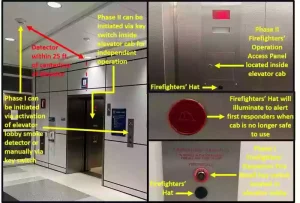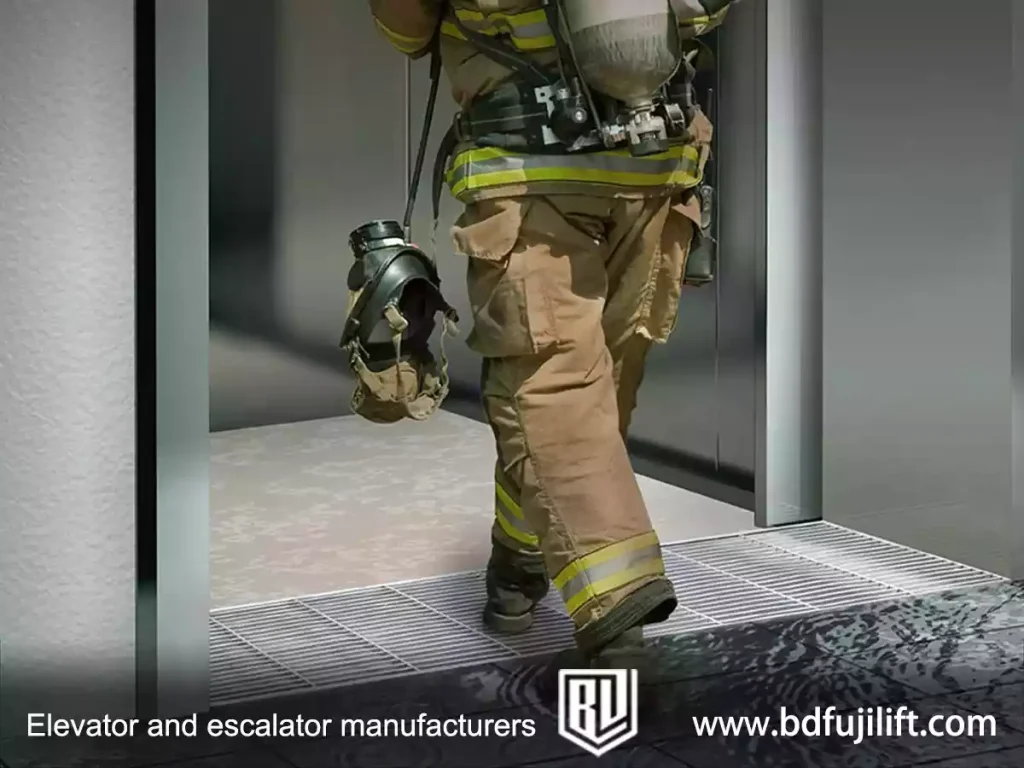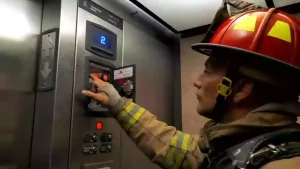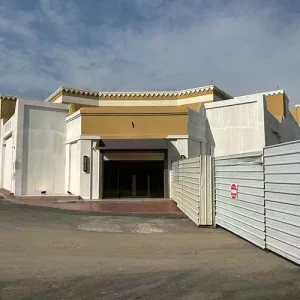A fire elevator is an important fire safety feature required in high-rise buildings, designed specifically to deal with fire situations. It provides firefighters with a fast way to reach the fire scene, quickly transporting firefighting equipment and personnel. It also helps evacuate trapped people, especially the elderly and those with limited mobility. Fire elevators are designed with fireproof, smokeproof, and waterproof functions to ensure they continue to work during a fire. As cities build taller buildings, the role of fire elevators becomes more important, and they are now an essential part of fire safety in high-rise buildings.
This article will introduce the basic functions, design requirements, and installation standards for fire elevators, helping you understand how to properly configure them.
What is a Fire Elevator?
A fire elevator (FSAE) is a special type of elevator designed for fire rescue, mainly used in high-rise buildings to provide firefighters with a fast way to reach fire scenes. Unlike regular elevators, fire elevators are equipped with fireproof, smokeproof, and waterproof functions to ensure safe and efficient transportation of firefighters and firefighting equipment during a fire. Generally, buildings over 120 feet (37 meters) tall need to have a fire elevator, but regulations may vary by location.

How Does a Fire Elevator Work?
Fire elevators have unique designs. In addition to dual power sources that ensure stable power supply, they are built with fireproof and smokeproof features. These features ensure that the elevator shaft and cabin are not affected by fire or smoke, providing a safe passage for rescue operations. The elevator can also automatically return to a safe base during a fire, allowing firefighters to enter quickly.
When Do You Need a Fire Elevator?
In general, buildings that are over 32 meters tall or have an area larger than 1500 square meters must install fire elevators. High-rise residential buildings, tower-style residences, and buildings with more than 12 floors all require at least one fire elevator.
What Should a Standard Fire Elevator Be Like?
A standard fire elevator should have the following features:
-
Weight capacity: At least 800kg to ensure it can carry firefighters and firefighting equipment.
-
Speed: The elevator should ensure the entire trip from the lowest floor to the highest floor takes no more than 60 seconds.
-
Fireproof and smokeproof features: The elevator shaft and cabin should be made from fire-resistant materials to prevent fire spread and should have smoke-proof systems.

Key Differences Between Fire Elevators and Regular Elevators
Fire elevators differ from regular elevators in several key ways, directly affecting their performance and safety during a fire.
| Feature | Fire Elevator | Regular Elevator |
|---|---|---|
| Function | Designed for firefighters and evacuation, with fireproof, smokeproof, and waterproof features | Mainly used for everyday transportation, lacks fire safety features |
| Power System | Dual power sources, ensures stable operation during a fire | Relies on a single power source, may stop during a fire |
| Fire Resistance | Uses fire-resistant materials in the shaft and cabin to prevent fire spread | No fire resistance, can fail during a fire |
| Evacuation Ability | Effectively evacuates people with limited mobility, reduces rescue time | Cannot be used for evacuation during a fire |
| Control System | Auto return, self-diagnosis, linked with fire control center | Cannot link with fire systems, lacks emergency response features |
| Maintenance | Regular checks of electrical, mechanical systems to ensure emergency functions work | Mainly for regular operation, does not consider fire-related emergencies |
Power and Arc Control
Fire elevators and regular elevators use different power systems. In the event of a fire, fire elevators use a dual power design, meaning if the main power source fails, the backup source automatically takes over, ensuring the elevator keeps running. In contrast, regular elevators typically rely on a single power source, which can be interrupted during a fire, causing the elevator to stop.
Fireproof and Smokeproof Design
Fire elevators are built with fire-resistant materials in both the cabin and shaft to stop fire and smoke from spreading, providing a safer evacuation route. They are also equipped with smoke-proof devices to ensure smoke does not enter the elevator cabin. Regular elevators do not have such fireproof designs, and during a fire, they can fill with smoke, creating a serious safety hazard during rescue and evacuation.
Evacuation Ability
Fire elevators not only provide firefighters with a quick vertical route, but they can also be used to evacuate trapped people, especially those with limited mobility, like the elderly or disabled. They work in coordination with evacuation stairs, forming a three-dimensional evacuation system to ensure a fast and safe evacuation. Regular elevators usually stop running during a fire and cannot be used for evacuation.
Control Systems and Safety
Fire elevators come with automatic return-to-base, self-diagnosis, and integration with the fire control center. During a fire, the elevator automatically returns to a safe base, allowing firefighters to enter quickly and report real-time information to the fire control center. Regular elevators do not have these emergency functions and cannot integrate with fire systems. In a fire, regular elevators will stop running and cannot provide a timely rescue route.
Cost and Installation Requirements
Since fire elevators must meet higher safety standards, such as dual power sources, fireproof and smokeproof features, and emergency control systems, their installation cost is usually higher than regular elevators. Moreover, fire elevators must follow strict building fire safety codes to ensure they operate effectively during a fire.
How Much Does a Fire Elevator Cost?
The installation cost of a fire elevator is typically higher than that of a regular elevator, ranging from $14,000 to $70,000 USD, depending on the following factors:
-
Building height and area: The height and area of the building directly affect the number of fire elevators needed. For example, for a building taller than 32 meters, each elevator could cost between $20,000 to $40,000 USD, and for more complex designs, the cost may increase.
-
Safety standards and design requirements: Fire elevators must meet strict fireproof, smokeproof, and waterproof standards, which increase the cost. This portion generally accounts for 30% to 40% of the total cost.
-
Installation complexity: Installing fire elevators often requires structural modifications and special configurations. For example, the elevator shaft and cabin must be set up independently, and additional fireproof materials and specialized systems may be needed. Installation costs typically range from $14,000 to $28,000 USD, depending on the complexity of the building.
-
System requirements: Fire elevator systems, including power, control, and communication systems, must meet high reliability standards. These high-spec systems typically add $7,000 to $21,000 USD to the cost.
Although fire elevators have higher installation costs, their critical role in ensuring fire safety and evacuation in high-rise buildings makes them a legally required facility.
How to Install a Fire Elevator?
The installation of a fire elevator is a complex process that involves several steps.
Installation Requirements
The installation of a fire elevator must strictly follow the building structure and fire safety codes. First, the elevator shaft and cabin must be set up independently, avoiding shared spaces with other elevators to ensure the elevator’s independence and safety during a fire. The shaft and cabin should comply with fire protection standards and use fire-resistant materials to prevent fire spread. All control systems, wiring, and equipment should also be fireproofed to ensure normal operation in high-temperature and smoke-filled environments.
In addition, the elevator’s power system must use a dual power design, with the main power coming from the municipal grid and a backup power supply, usually from a diesel generator or battery. During a fire, the elevator should automatically switch to the backup power supply to ensure power continuity.
Where Should a Fire Elevator Be Installed?
Fire elevators should be installed near the building’s main passageways to ensure quick and easy access to all floors. The elevator shaft should be close to key facilities like the fire control center and fire pump room, allowing firefighters to quickly enter the elevator and interact with the fire control center to get fire information and respond promptly.
Also, the entrances and exits of the fire elevator should be clearly marked, so they can be easily located and used during a fire. At least one exit should lead directly to the outside, allowing firefighters to enter and begin rescue operations.
Installation Process a Fire Elevator Be Installed?
Installing a fire elevator typically takes 3 to 6 months, including time for design, construction, testing, and delivery. Here are the steps involved:
-
Design Phase: Detailed design of the fire elevator according to the building’s structure, function, and fire safety needs. This includes the shaft size, cabin capacity, and control system setup. This phase requires approval from the fire department and relevant authorities.
-
Construction Phase: This includes building the elevator shaft and cabin, installing the control system, connecting to power and communication systems, etc. All installation work must strictly follow the design plan, ensuring correct system connections and preventing quality issues.
-
Testing and Commissioning: Once installed, the system undergoes full testing to ensure the power, control, and communication systems operate properly during a fire. The fireproof, smokeproof, and emergency control functions are also tested.
-
Acceptance Testing: After final safety tests, the fire elevator is officially accepted and ready for use.
FAQ
1. How long is the lifespan of a fire elevator?
The lifespan of a fire elevator is usually 15 to 20 years, depending on factors such as usage, maintenance, and environmental conditions. Regular maintenance and prompt repairs can help extend the elevator’s lifespan. Since fire elevators are often used in extreme conditions during fires, keeping them in good working condition is critical.
2. Can a fire elevator be installed with MRL (Machine Room-Less) design?
Yes, fire elevators can be installed with an MRL (Machine Room-Less) design. MRL elevators save space by integrating the drive system and control equipment in the shaft or another part of the building. However, fire elevators with MRL design must still meet all fireproof, smokeproof, and emergency control requirements. The design must be compatible with fire safety systems to ensure proper operation during a fire.
3. How is a fire elevator maintained on a daily basis?
Daily maintenance of a fire elevator is essential to ensure it functions properly during a fire. Regular maintenance tasks include:
-
Checking the elevator’s electrical, mechanical, and communication systems to ensure they are functioning.
-
Inspecting the fireproof features, including doors, materials, and smokeproof systems.
-
Cleaning and lubricating elevator parts to prevent wear and tear.
-
Checking emergency equipment like backup power, emergency lights, and fire communication systems to ensure they are ready for use.
-
Diagnosing and fixing any faults found during inspections.
Regular safety checks are recommended at least once a year, with necessary repairs and upkeep performed based on the elevator’s usage.








